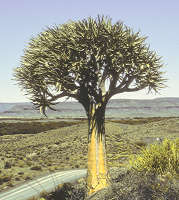The Asparagales is a widely distributed order of monocotyledenous flowering plants many of which are succulent, and includes around 29 families and 26,000 species. Obviously the order must include the Asparagaceae to which it lends its name but there is considerable diverity of form among the other members. Most members produce a tight cluster of leaves from the base of the plant. Many succulent members of the Asparagales grow as rosettes formed from fleshy, succulent leaves. Some members produce a stout trunk or caudex with age, which bears the cluster of leaves and in a few cases leaves are produced along a stem. Flowers are often produced at the end of a long stem and seeds of many species are covered with a black or bluish layer of phytomelanin, although this is missing in the case of seeds from e.g. Orchidaceae.
|
 Aloe dichotoma  Agave havardiana |
  Families of Succulent Plants Families of Succulent Plants 
|
|
Order Asparagales |
Search this site
 |
|
|
|
| Succulent Plant Search EngineBotanical BookmarksBotanical GlossarySITEMAPEmail: webmaster |


